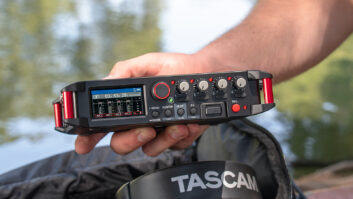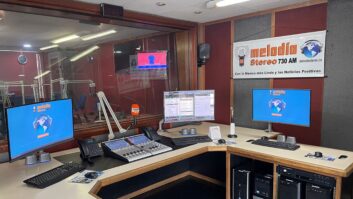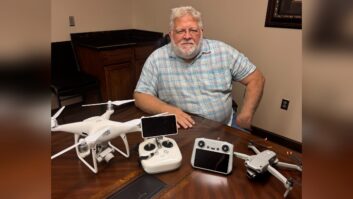In a world populated by compact mixers from Mackie, Shure and Behringer, the name Kamesan would not be among the first to trip off the tongue.
Product CapsuleThumbs Up
Simple, straightforward field mixer
Switchable output levels
Two voltage level phantom power
Solid RF immunity
Thumbs Down
Lacks limiter
No panpots
Relatively unknown in US
Price: $1,700
For information contact the U.S. distributor of Kamesan, HHB Communications USA Inc. in California at (805) 579-6490 or visit www.hhbusa.com or www.kamesan.info.
Not to worry. Many domestic broadcasters have never heard of this small Japanese manufacturer. But once you consider that Sigma Systems Engineering, the parent company of Kamesan, claims to hold 95 percent of the Japanese small-mixer market, then the name demands a little attention.
Among the products you might want to know about is the model KS-T2000. This is a compact three-input, stereo out audio mixer intended for field mixing duties in video production, but right at home as a basic three-mic mixer for many radio purposes.
The KS-T2000 will be the tiniest mixer you may ever bring to a remote broadcast. Set up and plugged into the codec box, it leaves you with more room on the table for giveaway T-shirts and CDs.
Combined with a pair of microphones and a portable DAT or MD recorder, a KS-T2000 turns the station’s executive meeting room into an impromptu interview/recording space when J-Lo or the president comes for a visit.
With its balanced stereo outputs, it can connect directly to a larger console, or to a basic consumer recording deck with a pair of unbalanced RCA inputs.
The KS-T2000 lacks certain extras like panpots and peak limiting, but it does include a 1 kHz calibration oscillator and three 160 Hz, -12/dB low-cut filters.
Should your studio location be the same as the transmitter and tower, you will be pleased to know RF immunity is good. Nothing will be leaking into your recording through the KS-T2000.
Got you covered
The KS-T2000 mixer has a durable softcover case that protects the unit against hard knocks on the way to a remote site or an interview. The case is festooned with hook-and-loop tabs and strips that fasten down stray XLR cables and bundle everything up to travel.
The mixer takes external DC power from 10 to 15 V, or from four AA batteries mounted in a slide-out clip. Running the KS-T2000 with a cheapie AC wallwart power supply could cause hum in your cans and on the recording. Lesser-quality units lack decent filtering and allow AC ripple to get through. If you are going to run the KS-T2000 off a battery eliminator, begin with a well-made one, or at least clap a good-sized electrolytic cap across an iffy one.
The KS-T2000 is well constructed, as is proper for a mixer intended for field TV use. ITT Cannon type XLR jacks, Alps switches and sealed potentiometers inhabit the interior. A rubber membrane under the front panel keeps dust, drizzle and hopefully diet soda out of the circuit boards inside.
Discrete components fill the circuit board rather than the surface-mount pieces typical of today’s manufactured products. It may still be a bear to repair, but at least unsoldering bad resistors is easier than wrestling with a magnifying glass and tweezers.
Some elaborate components appear as epoxied “mystery modules.” Do not expect to field-service a blown quad op-amp chip in this mixer.
The input knobs are not going to fall off or get yanked. These are held in place by screw-tightened collets rather than set screws. Other pots and rotary switches are recessed to avoid accidental hits.
Instead of panpots, Kamesan opted instead for toggle switches to assign inputs to the L or R outputs or to both. Not the worst – remote mics rarely are mixed in a panoramic fashion. And with the switches, audio can be hard-panned left and right to the two audio channels on a recording device.
Once dumped into a DAW at the station, both audio tracks can be separately EQ’d, ducked or otherwise processed, then mixed down to mono for air.
Recessed trimmer pots allow the adjustment of input gain before the main level control on each channel. Input selector switches let you dial in mic or line-level response and activate 12 or 48 V phantom power.
A voltage converter inside kicks the 6 VDC battery supply up to a useable voltage, which means that you may plow through batteries fairly quickly, especially if powering more than one microphone. The manufacturer states that better than eight hours of performance can be expected when using alkaline AA batteries. A three-segment LED display on the front will follow your battery status.
As mentioned, you can feed recorders with the balanced XLR and unbalanced RCA output jacks on the right side of the mixer. Originally, these jacks were intended to feed pro or semipro video cameras, which is why the XLRs include +4 line/-60 mic level switches. Presumably, it is possible to simultaneously drive a codec with the XLRs and run a cassette recording off the RCA jacks for an instant souvenir at remote broadcasts.
Radio people are going to wish the KS-T2000 had a 1/8-inch headphone jack to accommodate Walkman-type headsets. There is instead a 1/4-inch stereo jack for that purpose. I prefer the larger plug for use with more serious headphones and you are welcome to use an adapter for smaller plugs if desired.
Immunity
As I mentioned, the KS-T2000 is good at ignoring RF.
I ran the mixer on battery power in close proximity to two AM radio stations and a stretch of high-tension power lines in the greater Washington area. The metal shielding of the mixer did a complete job rejecting RF energy and the stray AC noise fields generated nearby, although it did reveal just how bad my microphone cables were. Time to switch to star quad.
Printed specifications show a frequency response of 50 Hz to 15 kHz, which is perfectly fine for FM radio and exemplary for AM.
It is hard to say if your jocks will ever use the low-cut filters. Many like to hear the throaty rumble of their voices in their headsets and may perceive a loss of lows when the filter is cut in. Of course, this is all in their heads.
Feel free to switch the filters in if the remote broadcast places you close to a generator, outdoor air conditioning exchanger or truck traffic, or just if the wind is a little stiff that day. Your talent will never notice.
I do bemoan the absence of a good peak limiter. Small mixers such as the ATI NanoAmp MXS100 and the classic Shure M367 include such a limiter for those moments when a jock gets carried away with excitement or a fan screams the call letters at full volume.
Because the Kamesan KS-T2000 is a mixer intended for video use, a limiter would be redundant (most field cameras have built-in compressors). Still, having one could make this unit a more popular choice as a remote audio mixer for radio.
The Kamesan KS-T2000 mixer is a capable performer for field and interior portable use. Solid metal construction means good RF rejection and XLR jacks that will not pull apart a case if the cable gets snagged. Quality sealed components assure long life, although how long is a good question (the manual lacks warranty information).
You won’t see as many of these mixers as you will a Mackie 1202 VLZ going out the door to a remote, but you may wish to look into the Kamesan KS-T2000. Remember, the company says they have 95 percent of the Japanese market; that kind of saturation begs a close look.







